Abstract
1. Parotid secretion has been studied by micropuncture in sodium-replete and sodium-deficient sheep. 2. The osmolality of unstimulated primary saliva was slightly higher than in plasma and fell following cholinergic nerve stimulation. In sodium-depleted animals the osmolality of final saliva was hypotonic and exhibited flow dependency, where as in sodium-replete animals it was always isotonic. 3. In sodium-replete sheep, the primary fluid sodium concentration was about 120-130 mmol l-1 but in final saliva it was about 167 mmol l-1 and showed little or no flow-dependency. In sodium-depleted sheep, the primary sodium concentration averaged only 82.2 mmol l-1 and it was concluded that sodium-depleted primary fluid contained some other unidentified solute that allowed it to remain approximately isotonic; in final saliva the unstimulated sodium concentration was about 40 mmol l-1 and it rose with increasing flow rate to a maximum of 114.9 mmol l-1. 4. The primary fluid potassium concentration in sodium-replete animals did not differ significantly from that seen in sodium-depleted animals and the values were uninfluenced by stimulation; the over-all mean value was 11.2 mmol l-1. In final saliva, in sodium-replete sheep, the potassium concentrations averaged 7.8 mmol l-1 but in sodium-depleted sheep the concentrations were between 5 and 10 times greater than in primary fluid. 5. It was calculated from the equilibrium pH that the primary bicarbonate concentration would have been about 35 mmol l-1. In final saliva, where bicarbonate was measured directly, the concentrations were much greater and increased with stimulation to about 115 mmol l-1. 6. The primary fluid phosphate and chloride concentrations were the same in both sodium-replete and sodium-depleted animals and were unchanged by stimulation; the mean concentration of phosphate was 1.30 mmol l-1 and of chloride, 53.0 mmol l-1. In final saliva the phosphate concentrations were little changed but the chloride concentrations fell to an average value of 20.0 mmol l-1. In final saliva it was found that the summed sodium and potassium concentrations exceeded the summed chloride, bicarbonate and phosphate (in mequiv l-1) concentrations, on average by 13.9 mequiv l-1, regardless of sodium status or flow rate. 7. The results indicate that secretion by the sheep parotid can be accounted for in terms of the standard two-state model. Phosphate seems to enter the saliva only in the primary fluid and potassium and bicarbonate appear to enter at both primary and secondary sites; sodium and chloride enter at the primary level and can be reabsorbed in the ducts. Salt depletion causes the primary fluid concentrations of sodium and chloride to fall and the content of an unidentified solute to rise markedly while, at the ductal level, it causes normally quiescent sodium and potassium transport processes to become activated.
Full text
PDF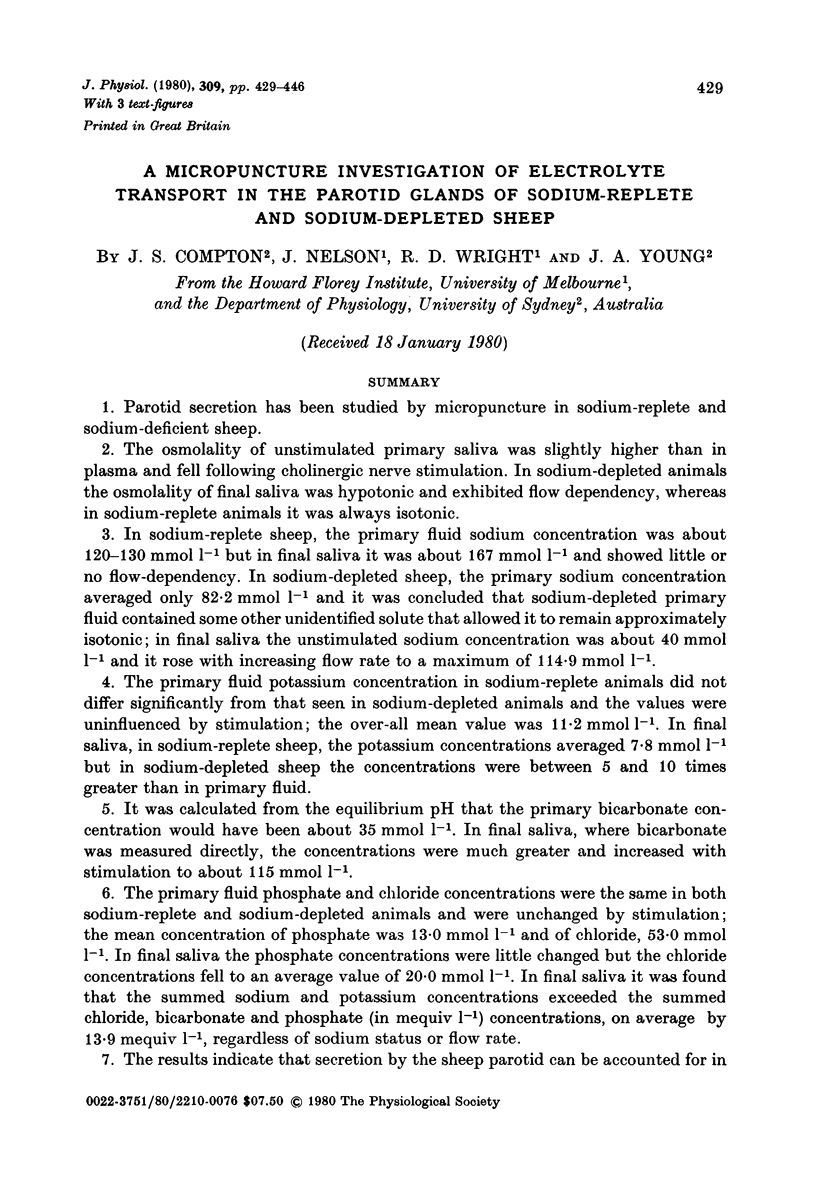
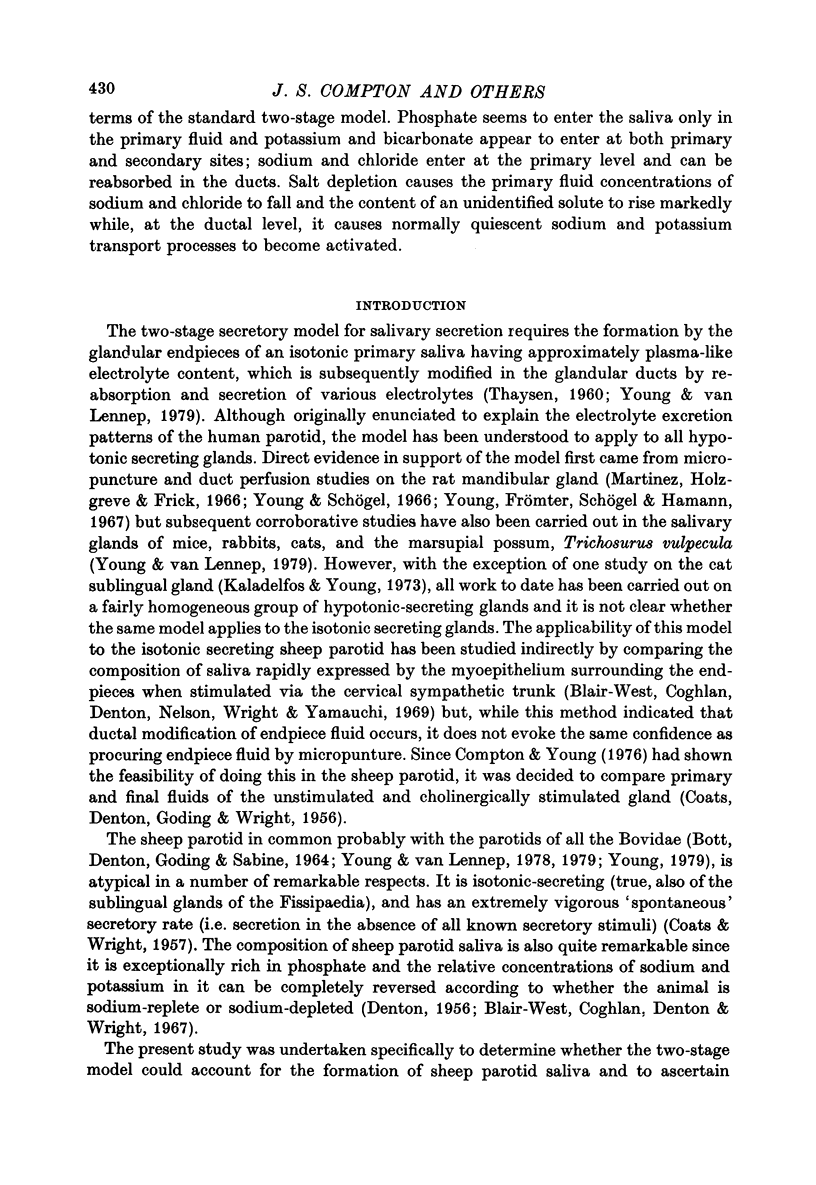
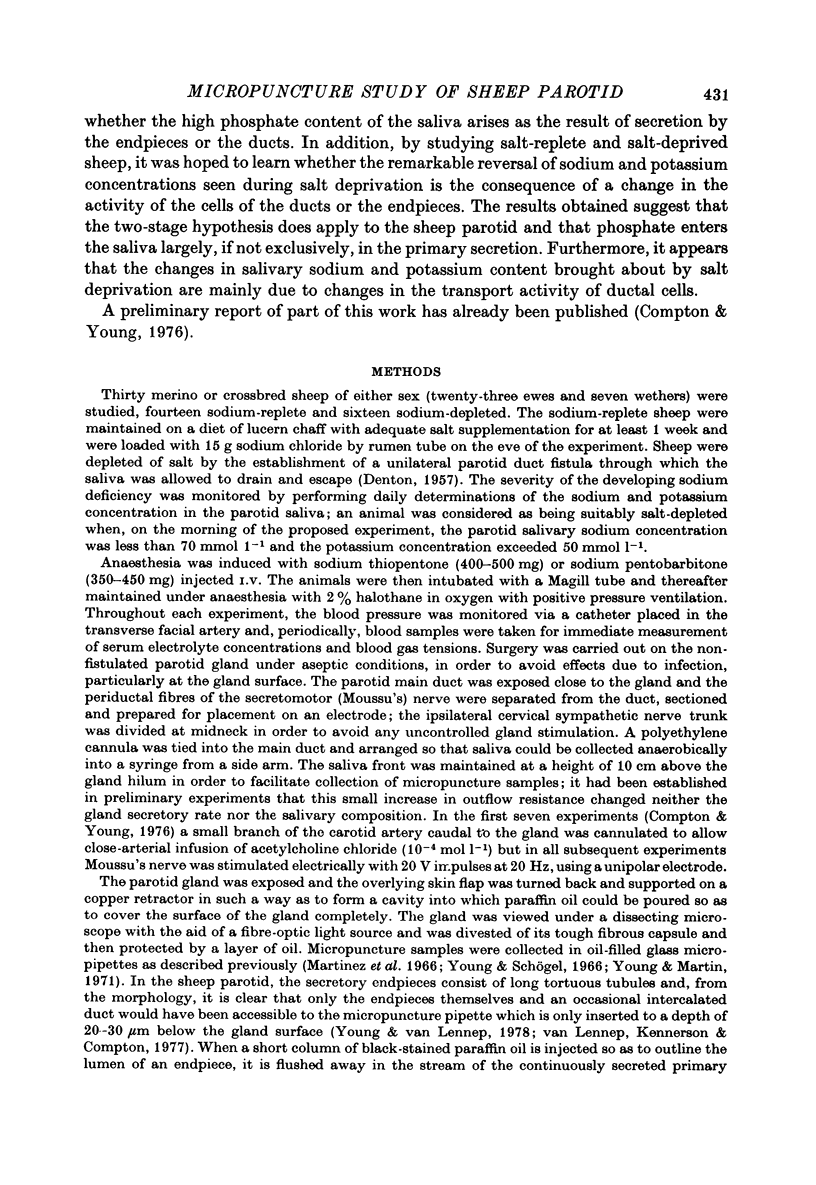
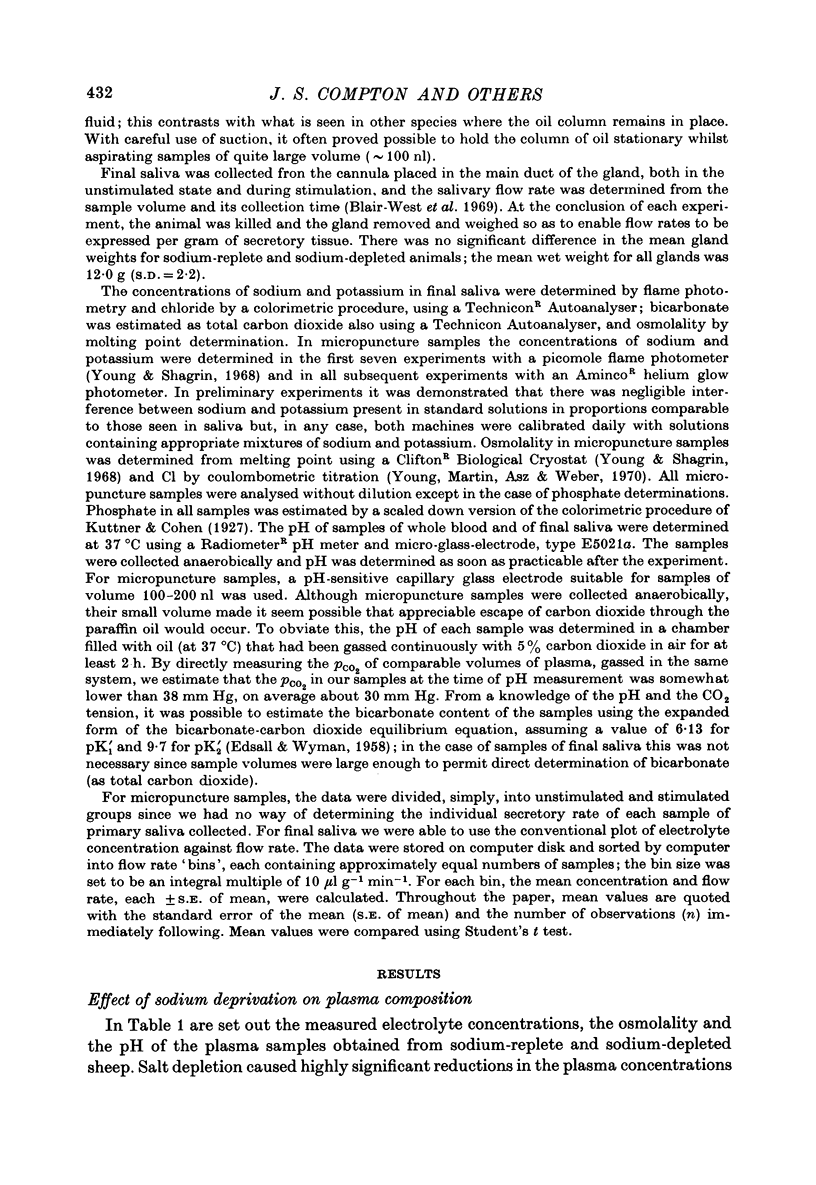


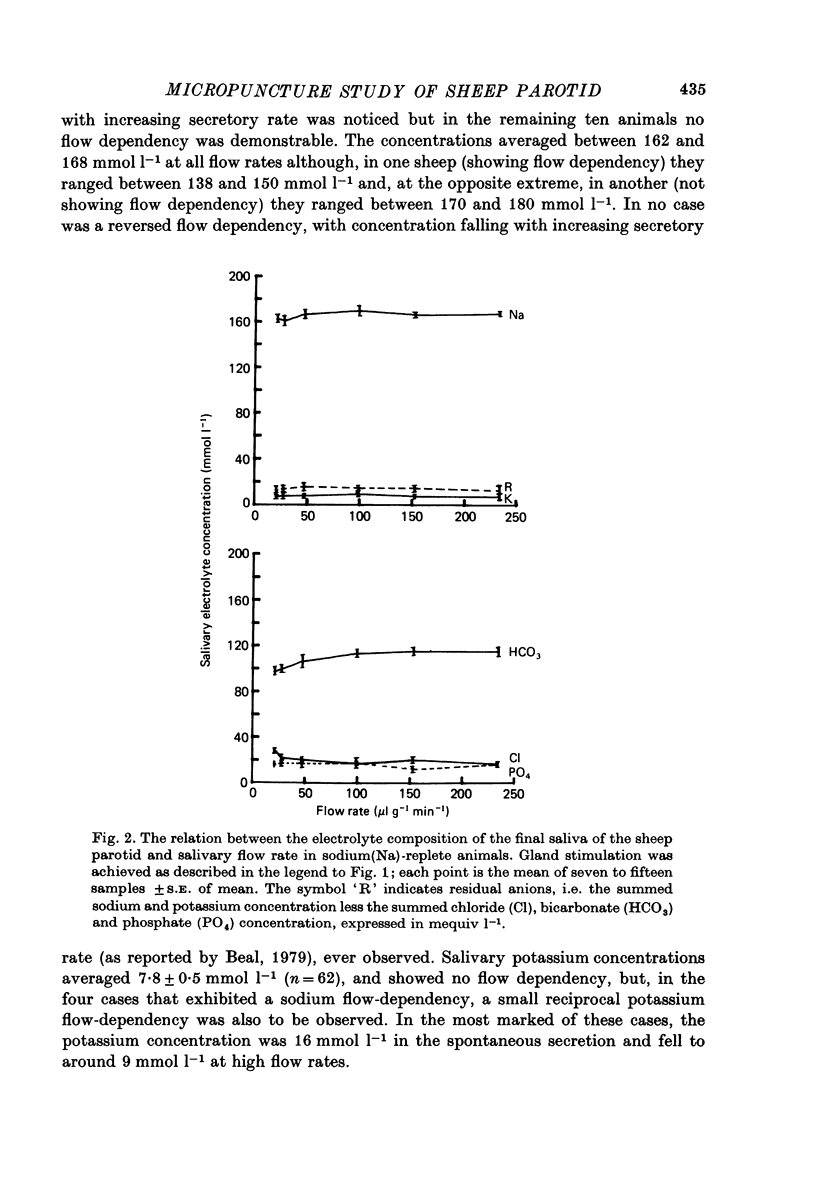
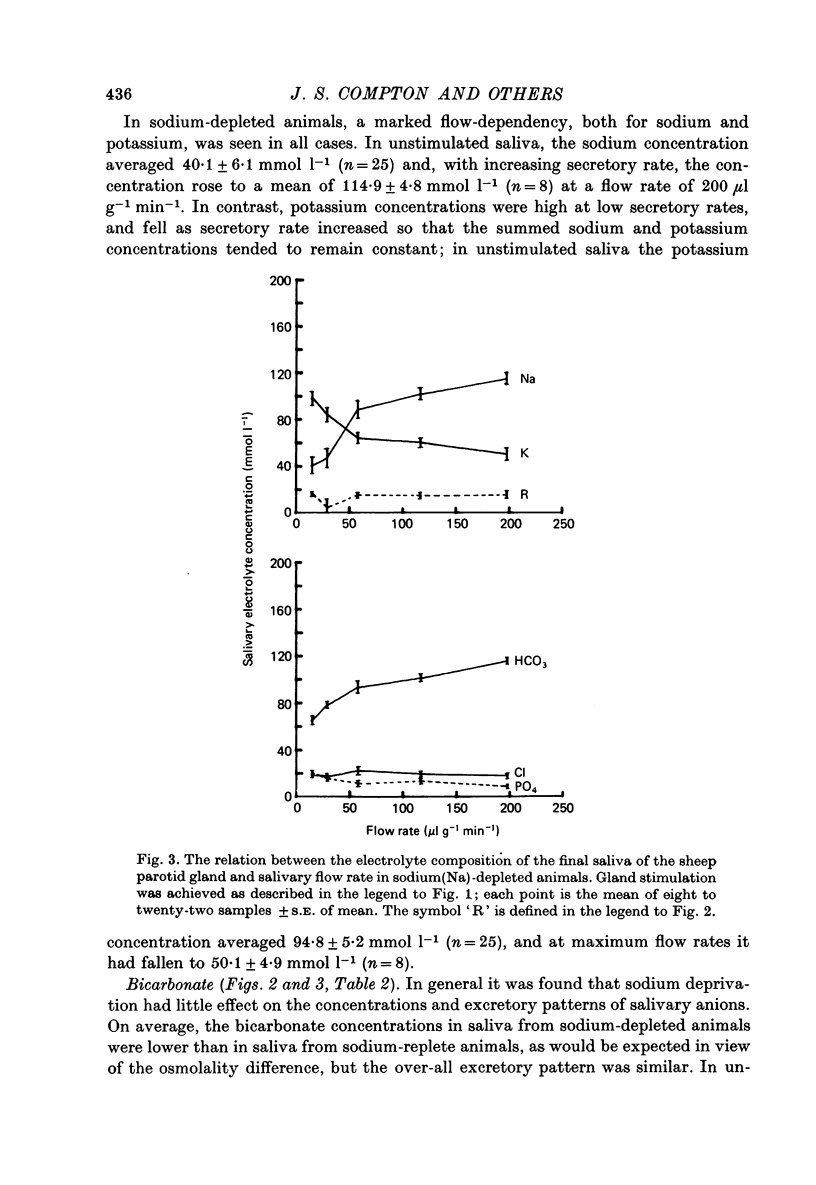
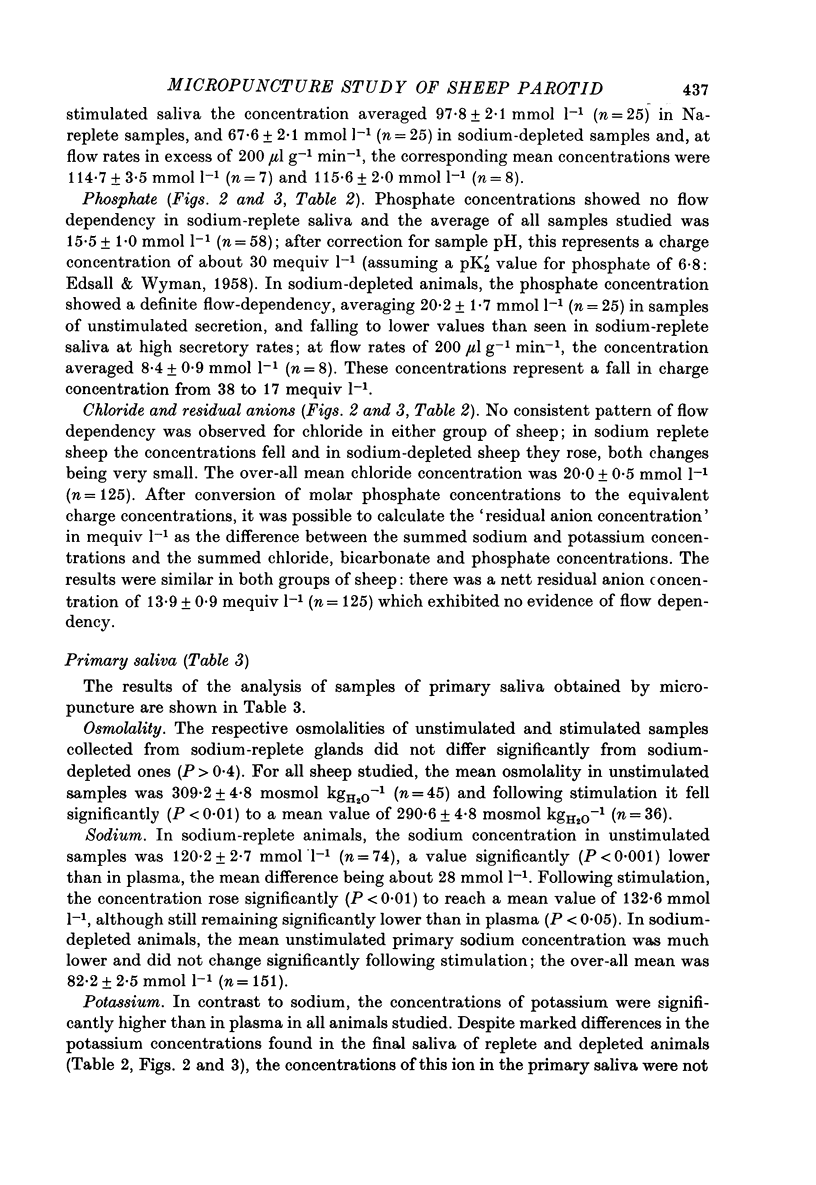
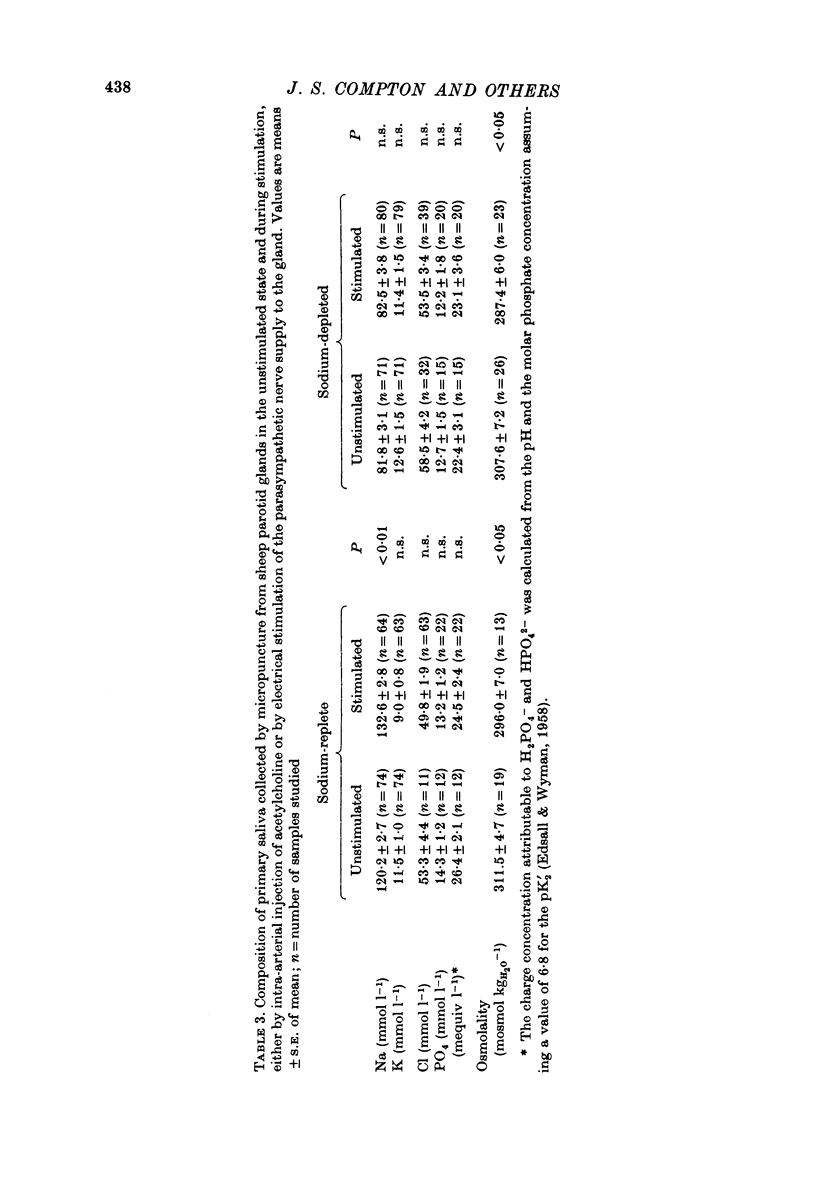
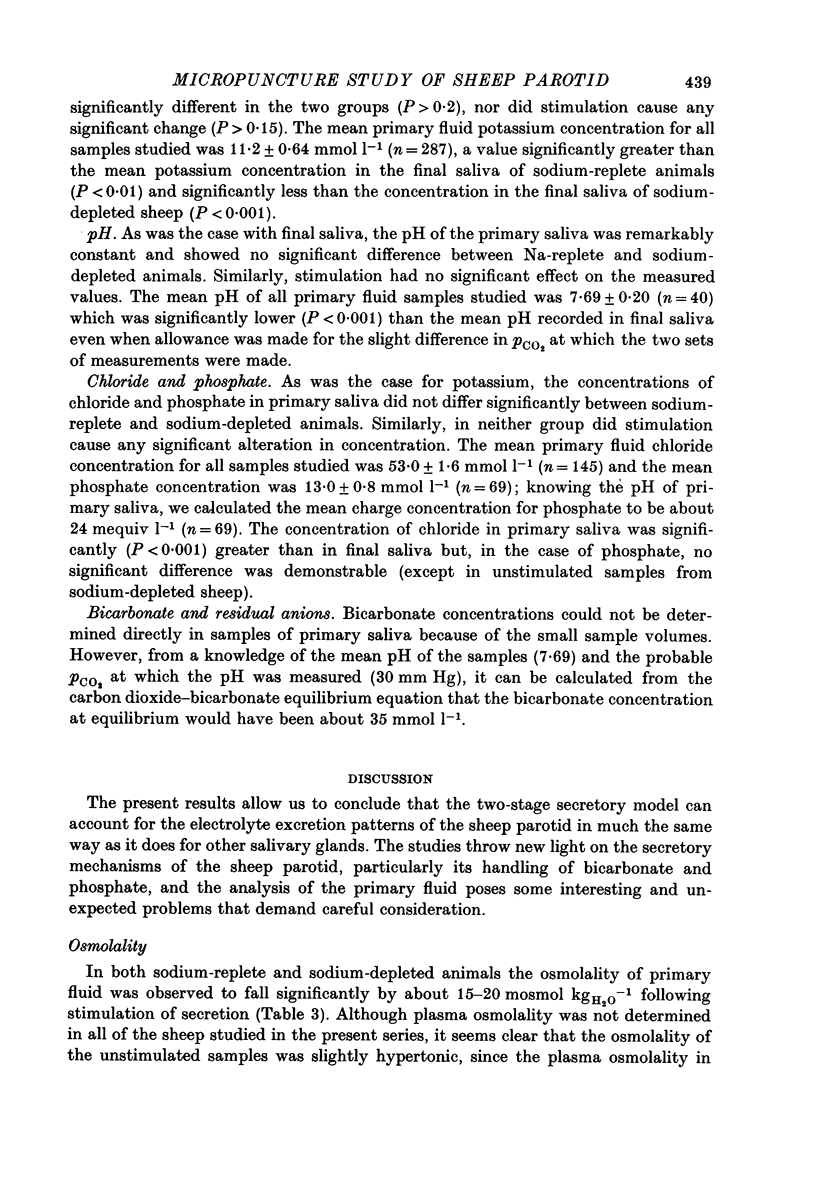
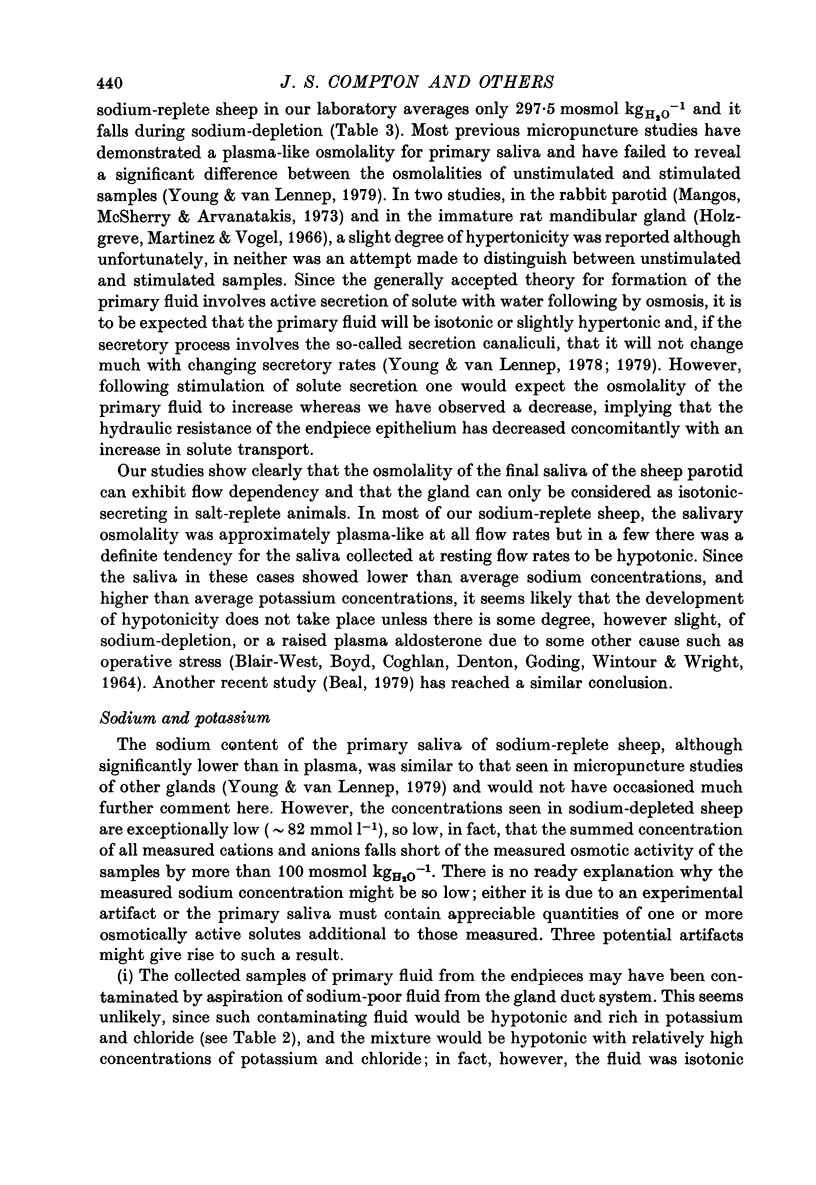
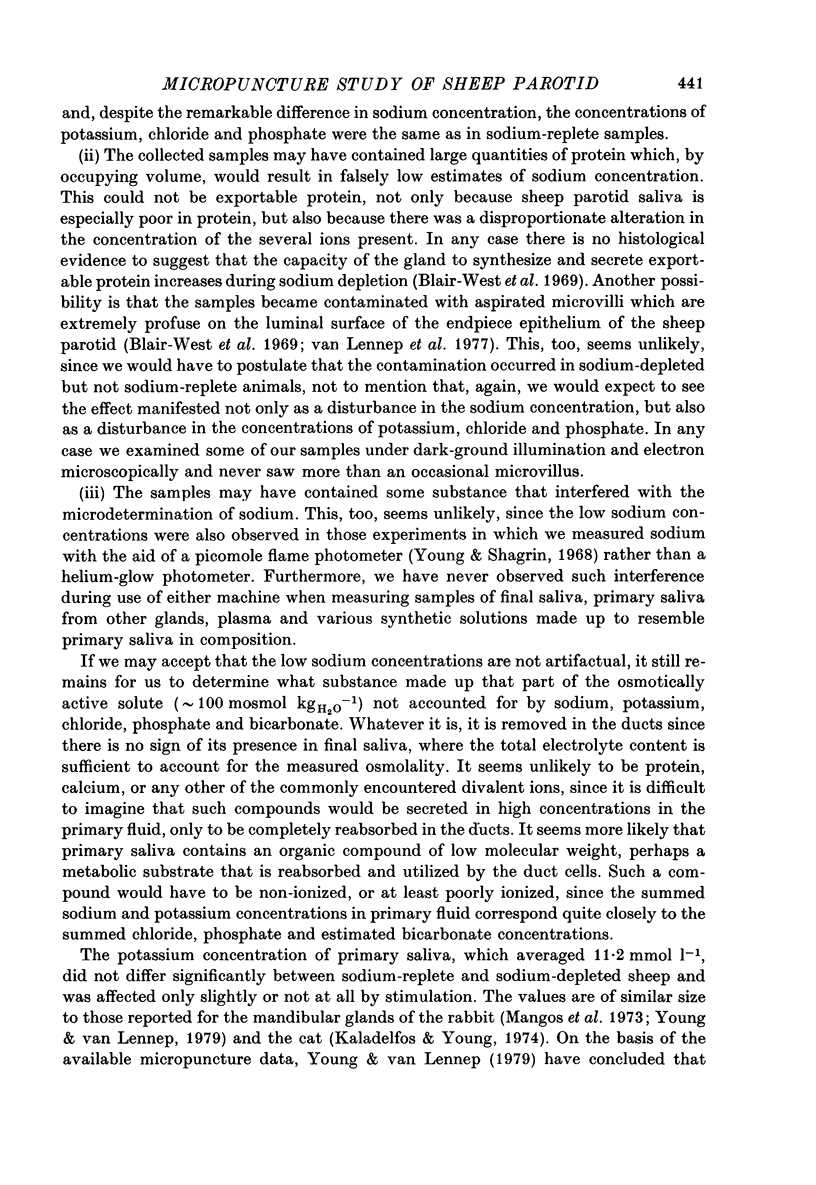
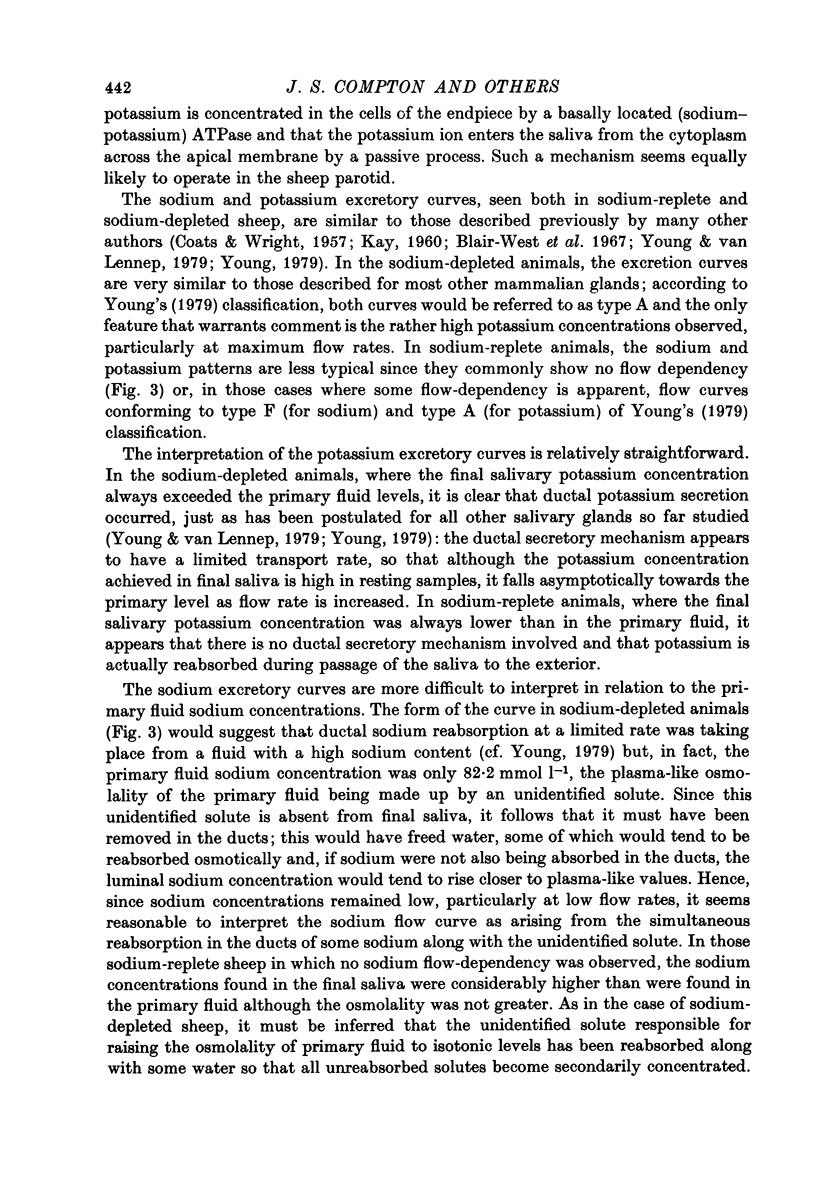
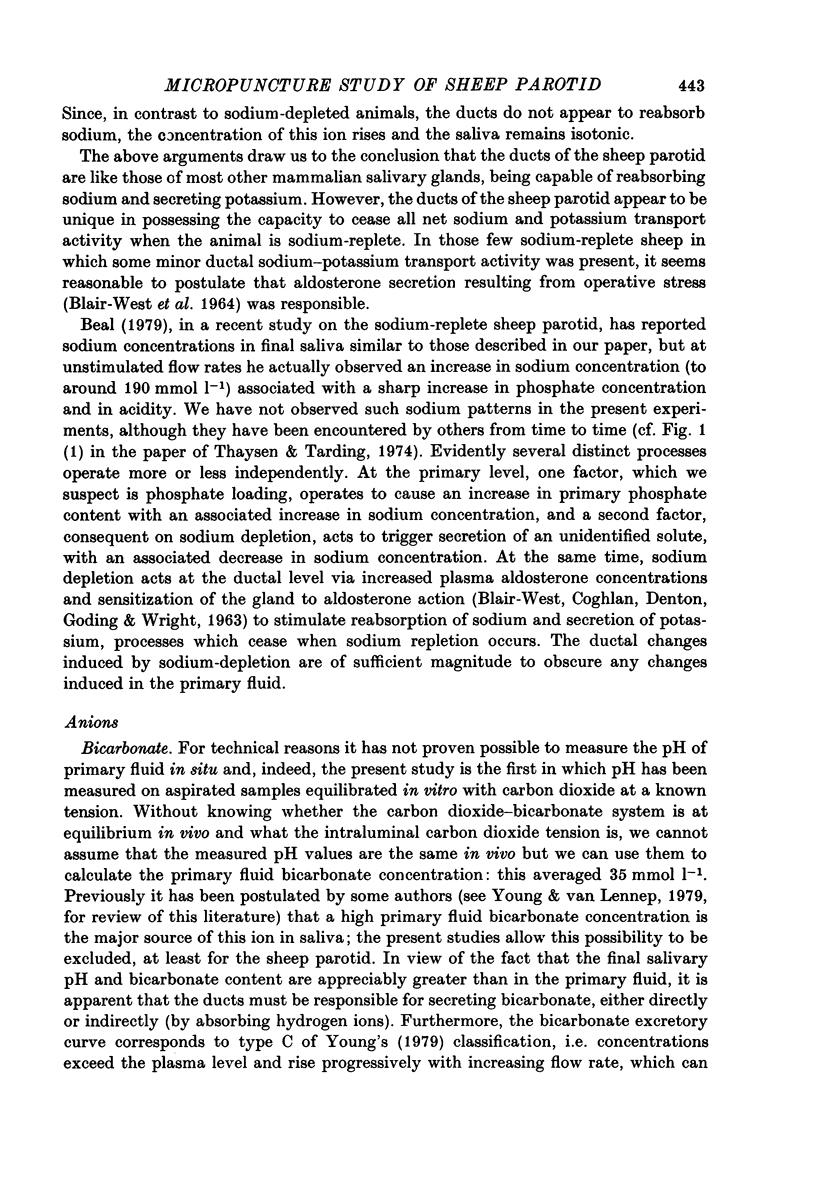

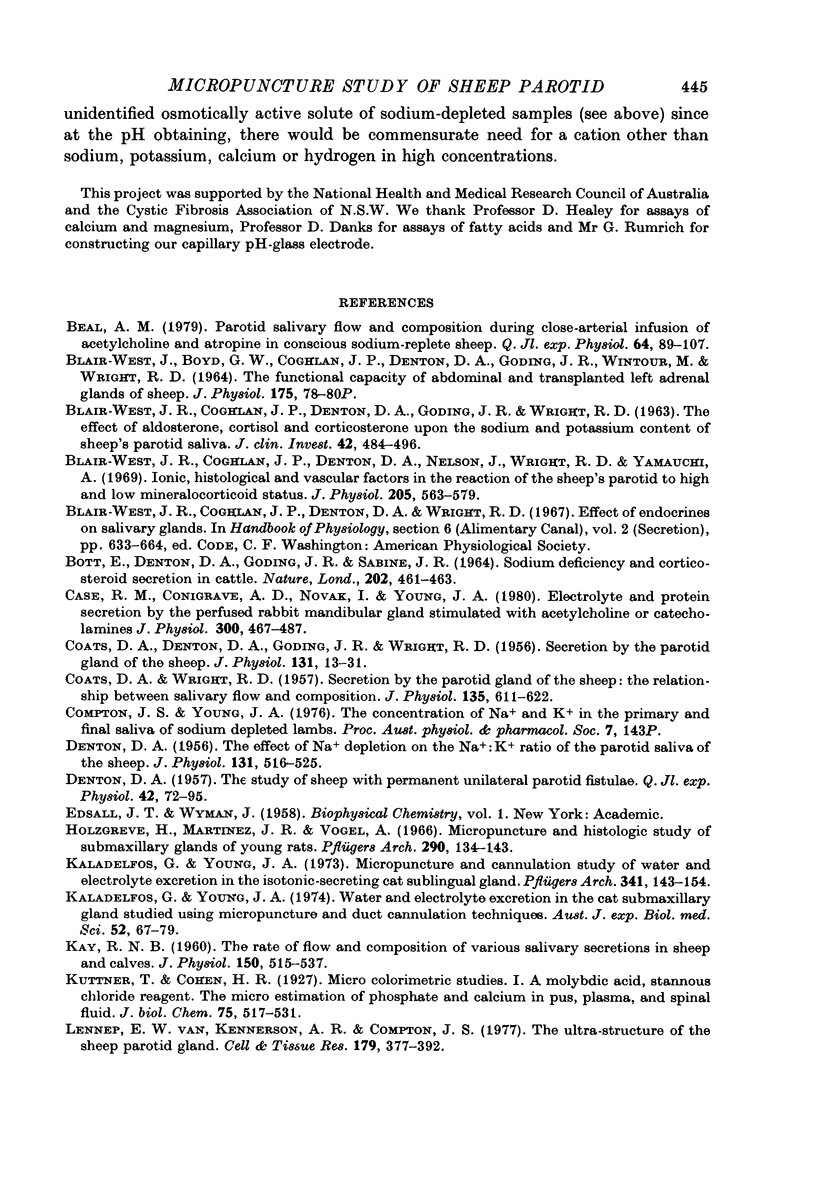
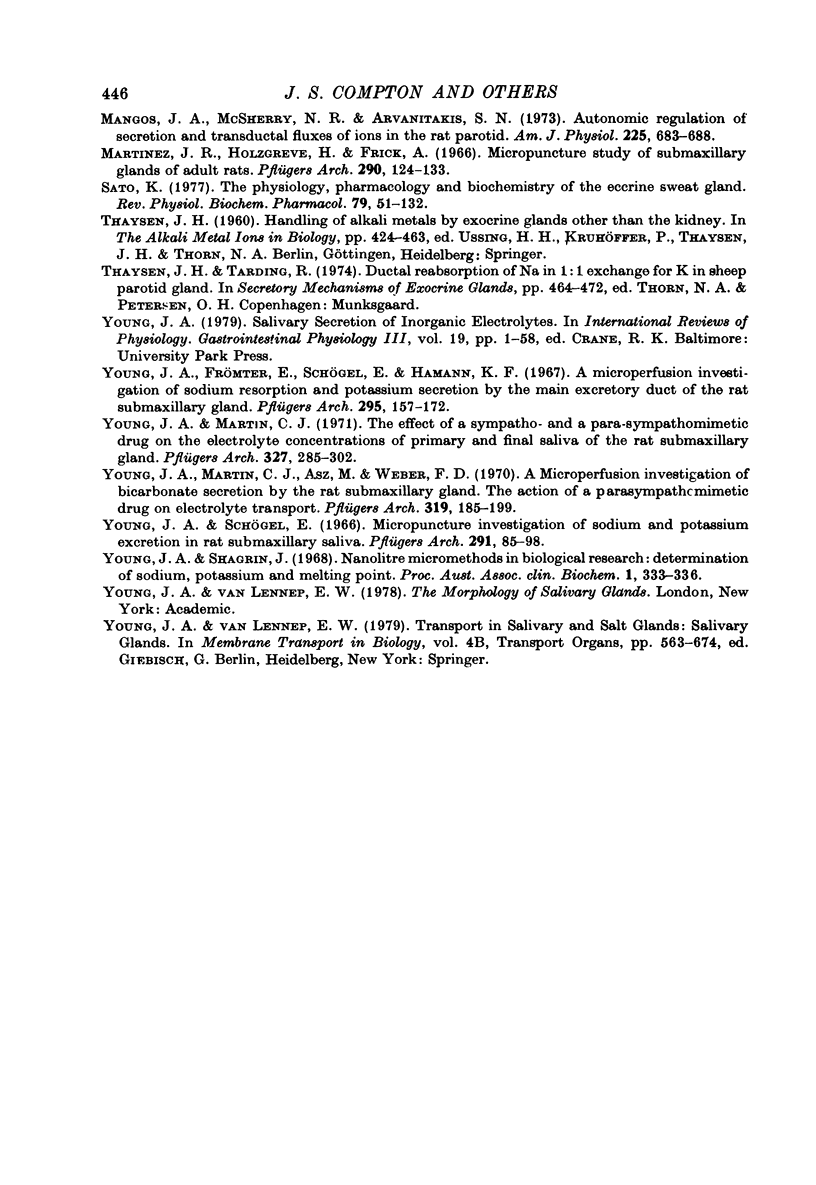
Selected References
These references are in PubMed. This may not be the complete list of references from this article.
- BLAIR-WEST J. R., COGHLAN J. P., DENTON D. A., GODING J. R., WRIGHT R. D. The effect of aldosterone, cortisol, and corticosterone upon the sodium and potassium content of sheep's parotid saliva. J Clin Invest. 1963 Apr;42:484–496. doi: 10.1172/JCI104737. [DOI] [PMC free article] [PubMed] [Google Scholar]
- BOTT E., DENTON D. A., GODING J. R., SABINE J. R. SODIUM DEFICIENCY AND CORTICOSTEROID SECRETION IN CATTLE. Nature. 1964 May 2;202:461–463. doi: 10.1038/202461a0. [DOI] [PubMed] [Google Scholar]
- Beal A. M. Parotid salivary flow and composition during infusion of acetylcholine and atropine into the carotid artery of conscious sodium-replete sheep. Q J Exp Physiol Cogn Med Sci. 1979 Apr;64(2):89–107. doi: 10.1113/expphysiol.1979.sp002467. [DOI] [PubMed] [Google Scholar]
- Blair-West J. R., Coghlan J. P., Denton D. A., Nelson J., Wright R. D., Yamauchi A. Ionic, histological and vascular factors in the reaction of the sheep's parotid to high and low mineralocorticoid status. J Physiol. 1969 Dec;205(3):563–579. doi: 10.1113/jphysiol.1969.sp008983. [DOI] [PMC free article] [PubMed] [Google Scholar]
- COATS D. A., DENTON D. A., GODING J. R., WRIGHT R. D. Secretion by the parotid gland of the sheep. J Physiol. 1956 Jan 27;131(1):13–31. doi: 10.1113/jphysiol.1956.sp005441. [DOI] [PMC free article] [PubMed] [Google Scholar]
- COATS D. A., WRIGHT R. D. Secretion by the parotid gland of the sheep: the relationship between salivary flow and composition. J Physiol. 1957 Mar 11;135(3):611–622. doi: 10.1113/jphysiol.1957.sp005734. [DOI] [PMC free article] [PubMed] [Google Scholar]
- Case R. M., Conigrave A. D., Novak I., Young J. A. Electrolyte and protein secretion by the perfused rabbit mandibular gland stimulated with acetylcholine or catecholamines. J Physiol. 1980 Mar;300:467–487. doi: 10.1113/jphysiol.1980.sp013173. [DOI] [PMC free article] [PubMed] [Google Scholar]
- DENTON D. A. The effect of Na+ depletion on the Na+ :K+ ratio of the parotid saliva of the sheep. J Physiol. 1956 Mar 28;131(3):516–525. doi: 10.1113/jphysiol.1956.sp005479. [DOI] [PMC free article] [PubMed] [Google Scholar]
- DENTON D. A. The study of sheep with permanent unilateral parotid fistulae. Q J Exp Physiol Cogn Med Sci. 1957 Jan;42(1):72–95. doi: 10.1113/expphysiol.1957.sp001244. [DOI] [PubMed] [Google Scholar]
- Holzgreve H., Martinez J. R., Vogel A. Micropuncture and histologic study of submaxillary glands of young rats. Pflugers Arch Gesamte Physiol Menschen Tiere. 1966;290(2):134–143. doi: 10.1007/BF00363691. [DOI] [PubMed] [Google Scholar]
- KAY R. N. The rate of flow and composition of various salivary secretions in sheep and calves. J Physiol. 1960 Mar;150:515–537. doi: 10.1113/jphysiol.1960.sp006402. [DOI] [PMC free article] [PubMed] [Google Scholar]
- Kaladelfos G., Young J. A. Micropuncture and cannulation study of water and electrolyte excretion in the isotonic-secreting cat sublingual salivary gland. Pflugers Arch. 1973 Jun 26;341(2):143–154. doi: 10.1007/BF00587321. [DOI] [PubMed] [Google Scholar]
- Kaladelfos G., Young J. A. Water and electrolyte excretion in the cat submaxillary gland studied using micropuncture and duct cannulation techniques. Aust J Exp Biol Med Sci. 1974 Feb;52(1):67–79. doi: 10.1038/icb.1974.5. [DOI] [PubMed] [Google Scholar]
- Mangos J. A., McSherry N. R., Arvanitakis S. N. Autonomic regulation of secretion and transductal fluxes of ions in the rat parotid. Am J Physiol. 1973 Sep;225(3):683–688. doi: 10.1152/ajplegacy.1973.225.3.683. [DOI] [PubMed] [Google Scholar]
- Martinez J. R., Holzgreve H., Frick A. Micropuncture study of submaxillary glands of adult rats. Pflugers Arch Gesamte Physiol Menschen Tiere. 1966;290(2):124–133. doi: 10.1007/BF00363690. [DOI] [PubMed] [Google Scholar]
- Sato K. The physiology, pharmacology, and biochemistry of the eccrine sweat gland. Rev Physiol Biochem Pharmacol. 1977;79:51–131. doi: 10.1007/BFb0037089. [DOI] [PubMed] [Google Scholar]
- Young J. A., Frömter E., Schögel E., Hamann K. F. A microperfusion investigation of sodium resorption and potassium secretion by the main excretory duct of the rat submaxillary gland. Pflugers Arch Gesamte Physiol Menschen Tiere. 1967;295(2):157–172. doi: 10.1007/BF00362747. [DOI] [PubMed] [Google Scholar]
- Young J. A., Martin C. J., Asz M., Weber F. D. A microperfusion investigation of bicarbonate secretion by the rat submaxillary gland. The action of a parasumpathomimetic drug on electrolyte transport. Pflugers Arch. 1970;319(3):185–199. doi: 10.1007/BF00586449. [DOI] [PubMed] [Google Scholar]
- Young J. A., Martin C. J. The effect of a sympatho- and a parasympathomimetic drug on the electrolyte concentrations of primary and final saliva of the rat submaxillary gland. Pflugers Arch. 1971;327(4):285–302. doi: 10.1007/BF00588449. [DOI] [PubMed] [Google Scholar]
- Young J. A. Salivary secretion of inorganic electrolytes. Int Rev Physiol. 1979;19:1–58. [PubMed] [Google Scholar]
- Young J. A., Schögel E. Micropuncture investigation of sodium and potassium excretion in rat submaxillary saliva. Pflugers Arch Gesamte Physiol Menschen Tiere. 1966;291(1):85–98. doi: 10.1007/BF00362654. [DOI] [PubMed] [Google Scholar]
- van Lennep E. W., Kennerson A. R., Compton J. S. The ultrastructure of the sheep parotid gland. Cell Tissue Res. 1977 Apr 20;179(3):377–392. doi: 10.1007/BF00221108. [DOI] [PubMed] [Google Scholar]


